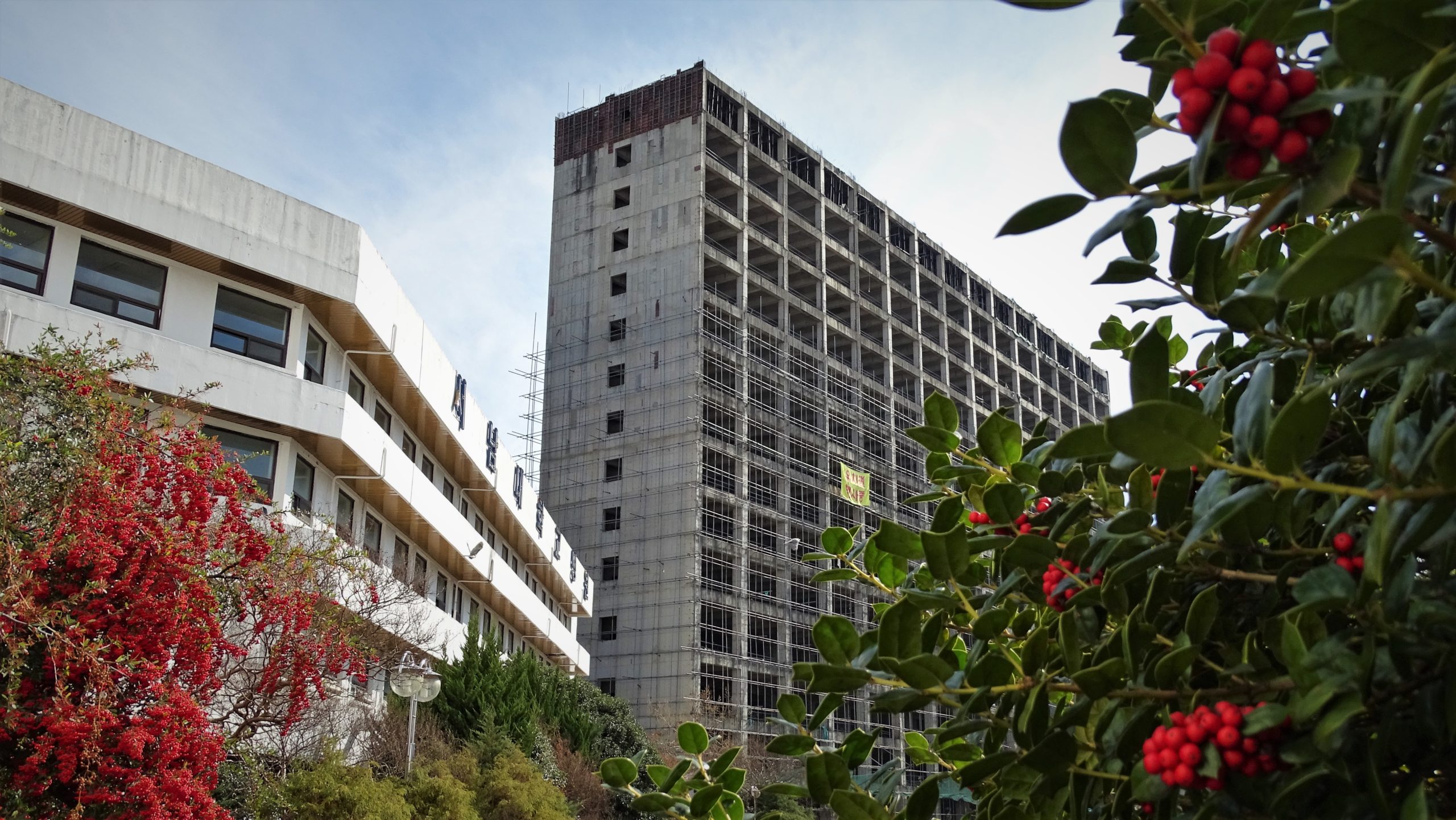Namgwang Hospital: The Demise of a Medical Disaster
Written and photographed by Isaiah Winters.
In last year’s August and September issues of the Gwangju News, I wrote of the hundreds of vials and jars containing human organs that a friend and I’d come across at an abandoned hospital here in town. Spotted in a dark backroom, the specimens had been left helter-skelter in open boxes that reeked of formaldehyde. Though I’d kept the hospital’s name and whereabouts purposely vague so as to discourage further vandalism, it was all for naught: In November, a wrecking crew was hired to gut the place over winter and is currently making rapid progress. Since the entire hospital will have been eviscerated – literally and figuratively – by the time this goes to print, I guess now’s as good a time as ever to explore its interesting backstory.
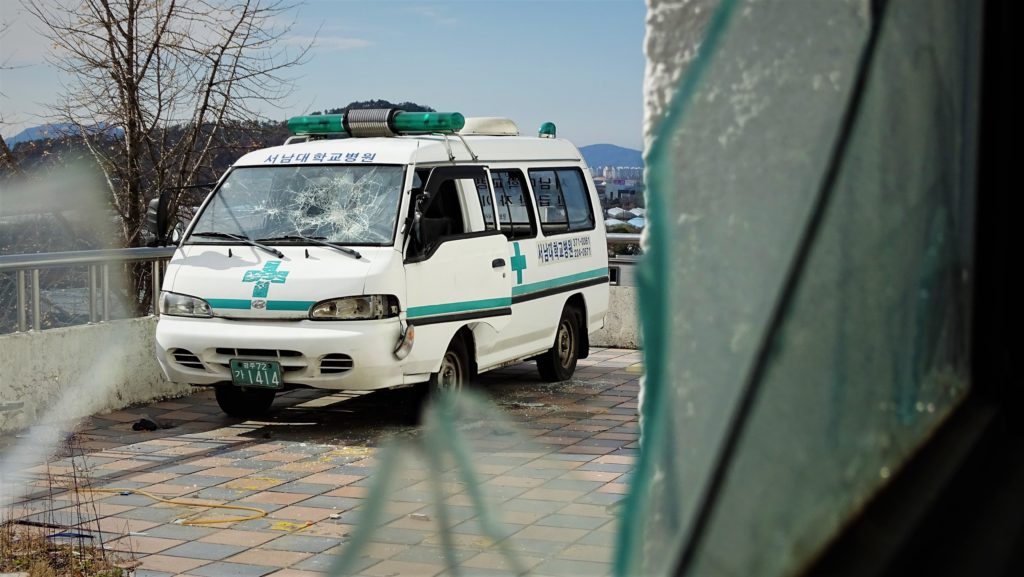
Located in Mareuk-dong, Namgwang Hospital struggled financially almost from the day it opened its doors in 1988. With heavy debts looming, the hospital was audited in 1994 by the Ministry of Health and Welfare, which found the hospital to be the furthest in arrears among the 35 hospitals then under scrutiny. Unable to pay its mounting debts, the hospital was soon acquired by Seonam University in 1995 and used as a training facility for medical students. However, this acquisition merely kept the hospital on life support. In 2011, said ministry disqualified Namgwang Hospital as a training facility and, in response, Seonam University filed a lawsuit to have the disqualification revoked, though to no avail.[1]
To dig into exactly why Namgwang Hospital lost its position as a training facility, a reporter from the Medical Times, Park Yang-myeong, turned up at the hospital in 2012 to have a look around. Describing it as “bleak,” Park found the hospital to be a virtual ghost town with hardly anyone coming or going. Cold beds, an elusive staff, and no heating along five floors of long, unlit corridors were what greeted him in the wards. Eventually, Park was able to find only six occupied beds and two nurses whom he described as silent rather than quiet. As for the hospital’s outpatients, Park said he observed fewer than ten during his two-hour visit.[2]
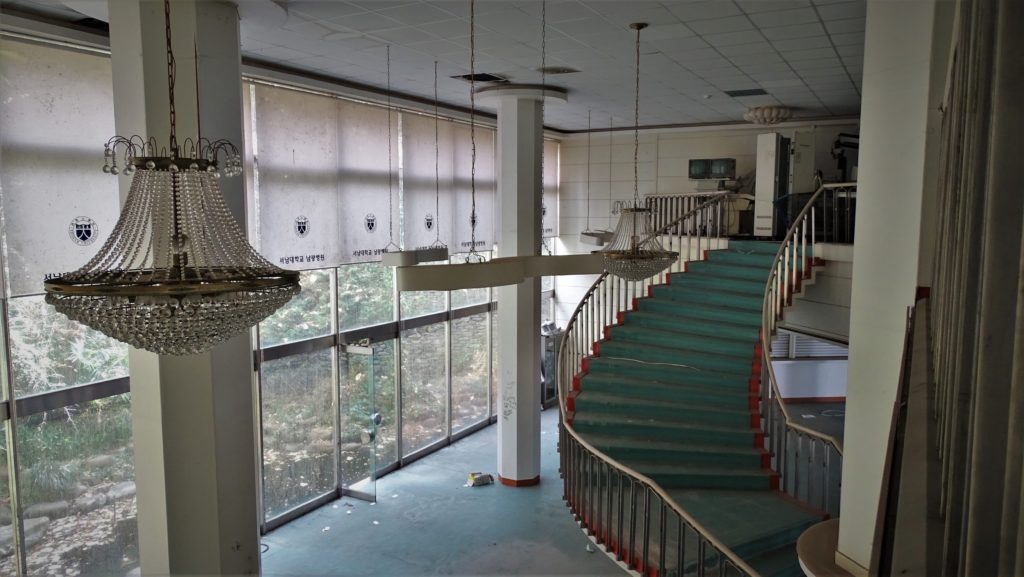
The hospital lobby and lush coy fish pond.On its own visit, the Ministry of Health and Welfare found 14 occupied beds, which is slightly more, but still only 2.8 percent of the hospital’s 500 beds. For comparison, any hospital designated as a training facility for students is required to have at least 70 percent of its beds occupied, which comes out to a minimum of 350 beds in the case of Namgwang Hospital.[3] With such a dismal occupancy rate, a natural question is whether the hospital was ever able to reach 70 percent occupancy. Of course, this is highly unlikely. Instead, the numbers of patients, occupied beds, and full-time specialists were found to have been inflated so the hospital could maintain its status as a training facility.[2]
Other oddities to emerge from the ministry’s investigation were germane to the hospital staff. In addition to getting low salaries of 1.5 million won per month, most of the 28 professors at the training facility were found to have been born between 1928 and 1930, which means they would have been over 80 years old at the time the hospital lost its training facility status. Also dodgy was the fact that some of the doctors were found to have been practicing on “borrowed medical licenses.”[3]
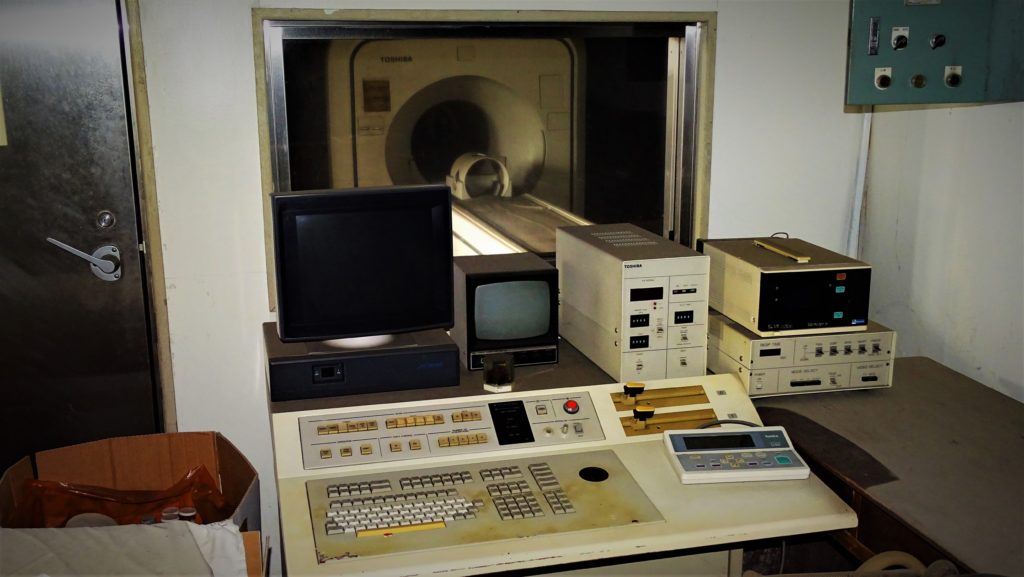
The MRI room containing boxes of organ and tissue specimens.When all these sordid details are considered as a whole, our discovery that an MRI room behind the hospital had been stuffed with flimsy boxes containing hundreds of organ and tissue specimens begins to make some morbid sense. It’s not hard to imagine some grizzled higher-up, in an effort to avoid responsibility, barking orders at a few unfortunate medical students to “just put ’em in the back” so the containers could be out of sight, out of mind. Of course, this is my most benign interpretation of how things might’ve unfolded.
On a recent visit to the hospital, I noticed that the organs had been packed up in cardboard hazmat boxes ready for removal, while most of the remaining medical equipment had been moved out of the hospital and into the parking lot. (I’m happy to report that the coy fish pond, though partly frozen over, was still in good shape.) Although I would’ve enjoyed keeping this hospital a secret for a while longer – mainly as a place to shock visiting friends – not having diseased organs lying around in warped cardboard boxes is generally a good thing.
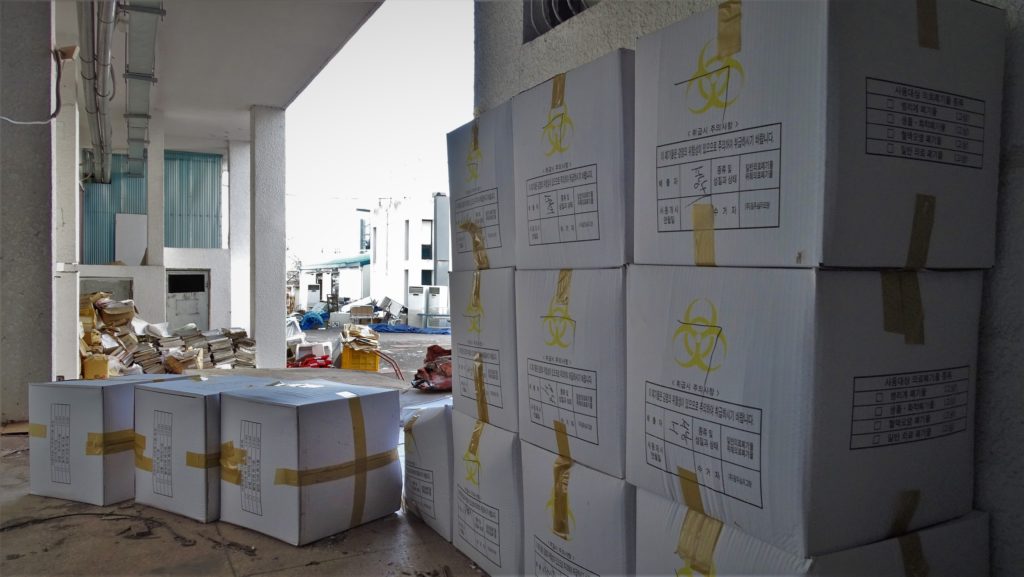
The diseased organ and tissue specimens sit in hazmat boxes ready for removal.I have no idea what’ll be done with Namgwang Hospital once it’s gutted over the next few months. In a way, I’ll miss it – I have a lot of weirdly fond memories there. For example, the unfinished building adjacent to the hospital used to have a rusty crane beside it that, once climbed, afforded one of the best views of Gwangju. (Sadly, my camera at the time was very poor quality, so the photos are unfit to print.) It was, in fact, the first crane I’d ever climbed, though it mysteriously went missing during the two years I was away from Gwangju. Further nostalgia comes from the fact that a few hospital scenes from the 2017 film A Taxi Driver were filmed there, primarily because the hospital maintained a 1980s vibe due to its owner’s reluctance to invest in its upkeep.
The founder of Seonam University, Lee Hong-ha, who presided over Namgwang Hospital’s mid-1990s acquisition and eventual demise, is now in jail for having embezzled over 100 billion won’s worth of money from his numerous education institutions. Interestingly, in August 2015, Lee got into a dispute with another inmate at Gwangju Prison over a fresh pair of underwear, which resulted in the then 76-year-old getting his ribs broken, in addition to other injuries.[4] Naturally, he was whisked away to the ICU at Chonnam National University Hospital for the treatment he needed, rather than to the ICU at Namgwang Hospital for the treatment he deserved.
Sources
[1] Moon Hyeon-ung. (2017, August 21). <디테일추적>영화 ‘택시운전사’, 서남대 부속병원을 세트장으로 쓴 이유는. Retrieved from the Chosun.com website: https://news.chosun.com/site/data/html_dir/2017/08/21/2017082101881.html
[2] Park Yang-myeong. (2012, March 19). 남광병원 실태 충격적 “수련병원이 이 지경이라니”. Retrieved from the Medical Times website: http://www.medicaltimes.com/Users/News/NewsView.html?ID=1073524
[3] Choi Wan-gyu. (2012, April 13). 병상가동률 2.8%···‘남광병원’의 불편한 진실. Retrieved from the Medical Today website: http://www.mdtoday.co.kr/mdtoday/index.html?no=184384
[4] Lee Hyeong-ju. (2015, December 26). ‘이홍하씨 수감중 폭행’ 발단은 새 속옷. Retrieved from the dongA.com website: http://www.donga.com/news/article/all/20151226/75579141/1
The Author
Originally from Southern California, Isaiah Winters is a Gwangju-based urban explorer who enjoys writing about the City of Light’s lesser-known quarters. When he’s not roaming the streets and writing about his experiences, he’s usually working or fulfilling his duties as the Gwangju News’ heavily caffeinated chief proofreader.



